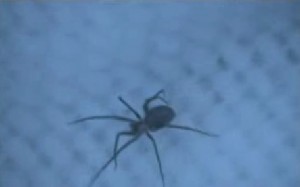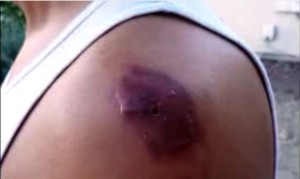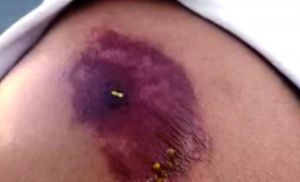The mouth parts on most spiders are not strong enough to bite into the human skin and hence a large percentage of the spider population across the United States is actually harmless. However, the brown recluse spider is an exception to this fact and is dangerous for human beings. However, one can take comfort from the fact that spider bites are very rare and most of such instances that are presumed to be spider bites, turn out be just an insect sting or some skin condition.
Brown recluse spiders are more common in the southern states in the United States. The general tendency of brown recluse spiders is to stay put in dry, warm climates and undisturbed areas like attics, woodpiles, under the sink, closets or basements.
The brown recluse spider is often referred to as a ‘violin spider’. The upper part of its back has a mark that resembles a violin and hence the nickname. It is not big in size and usually grows up to an inch in length. The bite from a brown recluse spider is very dangerous and requires immediate medical attention.
Brown recluse spider bite stages
However, the bite of a brown recluse spider is dangerous and results in the following signs and symptoms:
- Sensations of mild stinging that is generally followed by increased local redness
- The affected individual may experience severe pain within eight hours of brown recluse spider bite or the pain may occur much later.
- A blister that is filled with fluid then appears on the site. The blister sloughs off resulting in an enlarging and deep ulcer
- The reactions to a brown recluse spider bite tend to vary from rash and mild fever to listlessness and nausea.
- Fatalities from the bite are rare, but generally occur among children
Brown recluse spider bite symptoms
Some general symptoms from a brown recluse spider bite include:
- Fever
- Rash
- Vomiting
- Nausea
- Headache
- Joint stiffness or pain
- Pain in the abdomen
- A general feeling of being unwell or malaise
- Tension in the muscles or muscle cramping
A spider bite by a brown recluse or any other variety produces the same symptoms as shown by various types of skin conditions. Hence, if one has not actually observed being bitten by a spider, then the determination or diagnosis of a spider bite is not only difficult but next to impossible. The initial symptoms of a spider bite generally tend to be similar to Staphylococcal and Streptococcal infections, burns, early lesions of zoster or herpes simplex, early Lyme disease, thorn injury and bites or stings from other bugs or insects such as ticks, fleas, ants, mosquitoes, bedbugs and biting flies.
Studies indicate that a majority of the reported cases of spider bites turned out to be other skin conditions caused by factors other than spider bites.
Spider bite treatment
Most bites from spiders of the non poisonous variety results in irritation, local redness and pain. This can generally be treated at home by applying a wet cloth or cooling packs over the affected area to ease the swelling and consumption of pain relief medications to reduce the pain. Most spider bites resolve on their own in a week or ten days without any treatment. Also, the chances of allergic reactions from spider bites are miniscule and most cases of allergic reactions result from contact with spiders, rather than the spider bite itself.
Follow the instructions given below, in case of spider bites:
- The site of spider bite should be thoroughly washed with soap and water
- Pain and other symptoms can be reduced by over the counter pain killers. Avoid giving aspirin to children
- The spider bite area should be soothed by applying an ice pack or a cool compress over it
- In case the victim of a spider bite is a young child; if you believe that the bite may be caused by a brown recluse, if the bite location becomes infected, if symptoms of an allergic reaction appear or if there is development of severe fever or rash on the victim, then one should immediately seek emergency medical care.
- Depending on the immunization status of the patient, a tetanus booster shot may be provided.
- One may also bring along the spider to the doctor for identification purposes, so that appropriate treatment can be sought
Brown recluse spider bite treatment
In case of a bite by brown recluse spider, one needs to follow the steps given below:
- The affected area should be washed with water and soap
- The affected area should be elevated to prevent the spread of venom
- One can also tie a comfortable bandage above the affected area, in case the bite occurs on the leg or arm, to further prevent the spread of venom. Make sure the bandage is not very tight, else it may stop the circulation of blood altogether.
- One should always seek emergency medical attention. The doctors may use a variety of medications such as pain-killers, anti venom drugs, corticosteroids, etc. hospitalization may also be required in certain cases of brown recluse spider bite.
- Bring the spider to the doctor for definite identification
- The patient may require a tetanus booster shot depending on the immunization status.
- Contact the toxicology experts at the Poison Control Center in the United States. They will work along with the doctors to remedy the situation caused by brown recluse spider bite
The doctor may ask you questions about the time of the bite, any other history of allergies or medical conditions. He or she may ask you to go for a complete blood count test, urinalysis, blood clot tests, electrolyte balance test etc.
The treatment for black recluse spider bite treatment are in the form of tetanus shot administered, medication to relieve the pain, antihistamines to treat itching. Antibiotics are given in case; there is a wound in the affected, bitten area. You may have to take antibiotics till the secondary infections fade away.
The patient may have to do a follow-up with the doctor once in every 4 days to check how the wound is settling down. For the first three days after the examination by the physician, the follow-up has to be on a daily basis. The doctor may recommend hospitalization in case the individual has a systemic disease, an illness which affects various organs, tissues or the overall body.
The brown recluse bite can also cause necrosis, which means premature death of living tissue. In this case, the surgeon may remove the dead tissues in the area of black recluse spider bite.
Brown recluse spider bite pictures
Here are the pictures of brown recluse spider and its bite on skin


